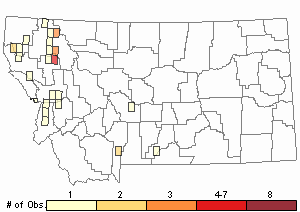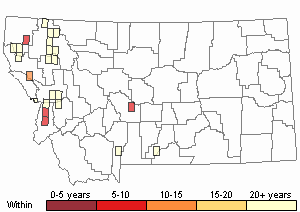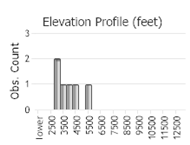View in other NatureServe Network Field Guides
NatureServe
Montana
Utah
Wyoming
Idaho
Wisconsin
British Columbia
South Carolina
Yukon
California
New York
Four Tooth Moss - Tetraphis pellucida
General Description
Plants: Acrocarpous (Vitt 1988). Growing in patches or clumps of erect shoots (Smith 1980), green above, russet below (FNA 2007), or sometimes a muted reddish-brown (Crum & Anderson et al. 1981). Stems upright, ca 8-15 mm, leafless below, crowded with leaves above (FNA 2007).
Leaves: Appressed slightly when dry (Smith 1980), spreading and folded when wet (FNA 2007), somewhat 3-ranked. Lower leaves small, widely spaced, ca 1-2 mm in length (Crum & Anderson et al. 1981), egg- to lance-shaped; costa terminating long before the leaf tip (FNA 2007). Upper leaves (and perichaetial bracts) becoming longer and more slender than those below, up to 3 mm (Crum & Anderson et al. 1981), linear (FNA 2007), those of the sterile stems often dense, creating gemma cups (Smith 1980), acute; margins smooth and bent back and downward; costa ending just before the leaf tip (FNA 2007).
Cells of Distal Leaves: Laminal cells incrassate, 6 sided with the corners erratically rounded in the upper part of the leaf, transitioning to rectangular-linear shapes in the basal part of the leaf (FNA 2007).
Tetraphis pellucida var. pellucida: Present in Montana (FNA 2007).
Tetraphis pellucida var. trachypoda: Present in Montana (FNA 2007).
Phenology
Fruit ripening in spring to the first part of summer (FNA 2007).
Range Comments
Tetraphis pellucida (variety unspecified): Known in Montana from Cascade, Flathead, Gallatin, Granite, Lake, Lewis & Clark, Lincoln, Mineral, Missoula and Sanders Counties (Elliott 2016).
North American Range
Variety pellucida: AK to NL and NS, most states in the eastern half of the USA, SD, MT to CO, ID, NM, WA s to CA (FNA 2007).
Variety trachypoda: NT, BC, and NL in Canada, and MT, WY and CO in the USA; rare (FNA 2007). Known in Montana from Fergus, Flathead, Lake and Ravalli Counties (Elliott 2016).
Observations in Montana Natural Heritage Program Database
Number of Observations: 38
(Click on the following maps and charts to see full sized version)
Map Help and Descriptions
Relative Density

Recency



 (Observations spanning multiple months or years are excluded from time charts)
(Observations spanning multiple months or years are excluded from time charts)
Habitat
Tetraphis pellucida: An acidophile (Crum & Anderson et al. 1981).
Variety pellucida: Well-rotted wood, and occasionally on soil high in humus (FNA 2007); rarely on sandstone walls of stream gorges (Crum & Anderson et al. 1981).
Variety trachypoda: Well-rotted wood (FNA 2007) and peaty soil (Elliott 2016), including the peaty soil in animal tunnel openings in the tundra (Crum & Anderson et al. 1981).
Ecology
Rain splattering in gemma cups apparently aids in scattering the gemmae to new sites (Crum & Anderson et al. 1981).
Reproductive Characteristics
Autoicous. Antheridia and archegonia found near the bottom of the plant on short stems, some stems with perigonia only. Seta upright, sometimes a little bent or twisted, 6-14 mm in length. Capsule exserted, 2-3 mm in length, brown to russet (FNA 2007); calyptra extending to about mid-capsule (Lawton 1971); peristome teeth 4, those slender and deltoid, sometimes rupturing, giving the impression of more than 4 teeth (FNA 2007).
Gametophores (stems of gametophytes) grow from the buds of leaf-like, ephemeral protonematal flaps produced by the protonema (FNA 2007).
Specialized vegetative reproduction by gemmae produced in cups of bracteal rosettes occurring at the top of a sterile stem; gemmae stalked, plate-shaped, with numerous cells, generally present (FNA 2007).
Variety pellucida: Outermost cells of the seta smooth and twisting around the stalk its whole length (FNA 2007).
Variety trachypoda: Outermost cells of the seta typically slightly papillose proximally, the cells twisting around the entire stalk and mingling with patches of straight cells that are minutely papillose from protruding cell ends (prorulate) (FNA 2007).
Stewardship Responsibility
References
- Literature Cited AboveLegend:
 View Online Publication
View Online Publication Crum, H.A. and L.E. Anderson. 1981. Mosses of Eastern North America. 2 volumes. Columbia University Press, New York. 1328 pp.
Crum, H.A. and L.E. Anderson. 1981. Mosses of Eastern North America. 2 volumes. Columbia University Press, New York. 1328 pp. Elliott, J.C. and A.K. Pipp. 2018. A Checklist of Montana Mosses (1880-2018). Updated 3 January, 2020. Montana Natural Heritage Program, Helena, Montana. 73 pp.
Elliott, J.C. and A.K. Pipp. 2018. A Checklist of Montana Mosses (1880-2018). Updated 3 January, 2020. Montana Natural Heritage Program, Helena, Montana. 73 pp. Flora of North America Editorial Committee, eds. 2007. Flora of North America North of Mexico. Volume 27. Bryophytes: Mosses, Part 1. Oxford University Press, Inc., NY. xxi + 713 pp.
Flora of North America Editorial Committee, eds. 2007. Flora of North America North of Mexico. Volume 27. Bryophytes: Mosses, Part 1. Oxford University Press, Inc., NY. xxi + 713 pp. Lawton, E. 1971. Moss Flora of the Pacific Northwest. Hattori Botanical Laboratory. Japan: Yamabuki-cho, Shinjuku-ku, Tokyo. 362 pages plus appendices.
Lawton, E. 1971. Moss Flora of the Pacific Northwest. Hattori Botanical Laboratory. Japan: Yamabuki-cho, Shinjuku-ku, Tokyo. 362 pages plus appendices. Smith, A.J.E. 1980. The Moss Flora of Britain and Ireland. Cambridge University Press, Cambridge. 705 pp.
Smith, A.J.E. 1980. The Moss Flora of Britain and Ireland. Cambridge University Press, Cambridge. 705 pp. Vitt, D. J. Marsh, and R. Bovey. 1988. Mosses, Lichens & Ferns of Northwest North America. Seattle, WA: University of Washington Press. 296 p.
Vitt, D. J. Marsh, and R. Bovey. 1988. Mosses, Lichens & Ferns of Northwest North America. Seattle, WA: University of Washington Press. 296 p.
- Additional ReferencesLegend:
 View Online Publication
View Online Publication
Do you know of a citation we're missing? Elliot, J. C. 1993. Second checklist of Montana mosses. Unpublished report. U.S. Forest Service, Region 1. Missoula, MT. 45 pp.
Elliot, J. C. 1993. Second checklist of Montana mosses. Unpublished report. U.S. Forest Service, Region 1. Missoula, MT. 45 pp. Lawton, E. 1971. Keys for the Identification of the Mosses on the Pacific Northwest. Reprinted from 'Moss Flora of the Pacific Northwest'. Published as Supplement No. 2 of the Journal of the Hattori Botanical Laboratory. Nichinan, Miyazaki, Japan. 66 pp.
Lawton, E. 1971. Keys for the Identification of the Mosses on the Pacific Northwest. Reprinted from 'Moss Flora of the Pacific Northwest'. Published as Supplement No. 2 of the Journal of the Hattori Botanical Laboratory. Nichinan, Miyazaki, Japan. 66 pp. Malcolm, B., N. Malcolm, J. Shevock, and D. Norris. 2009. California Mosses. Nelson, New Zealand: Micro-Optics Press. 430 pp.
Malcolm, B., N. Malcolm, J. Shevock, and D. Norris. 2009. California Mosses. Nelson, New Zealand: Micro-Optics Press. 430 pp.
- Web Search Engines for Articles on "Four Tooth Moss"





